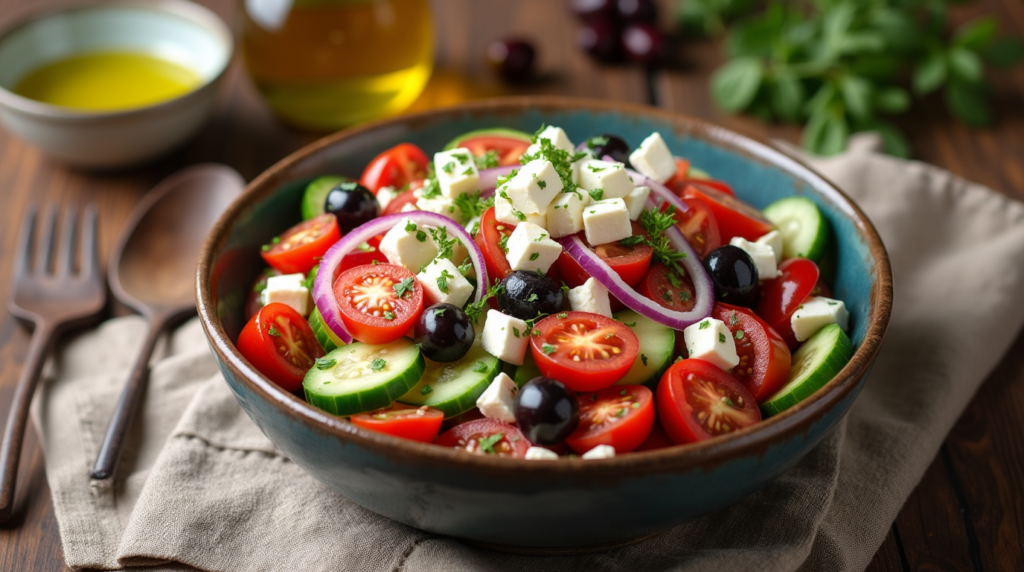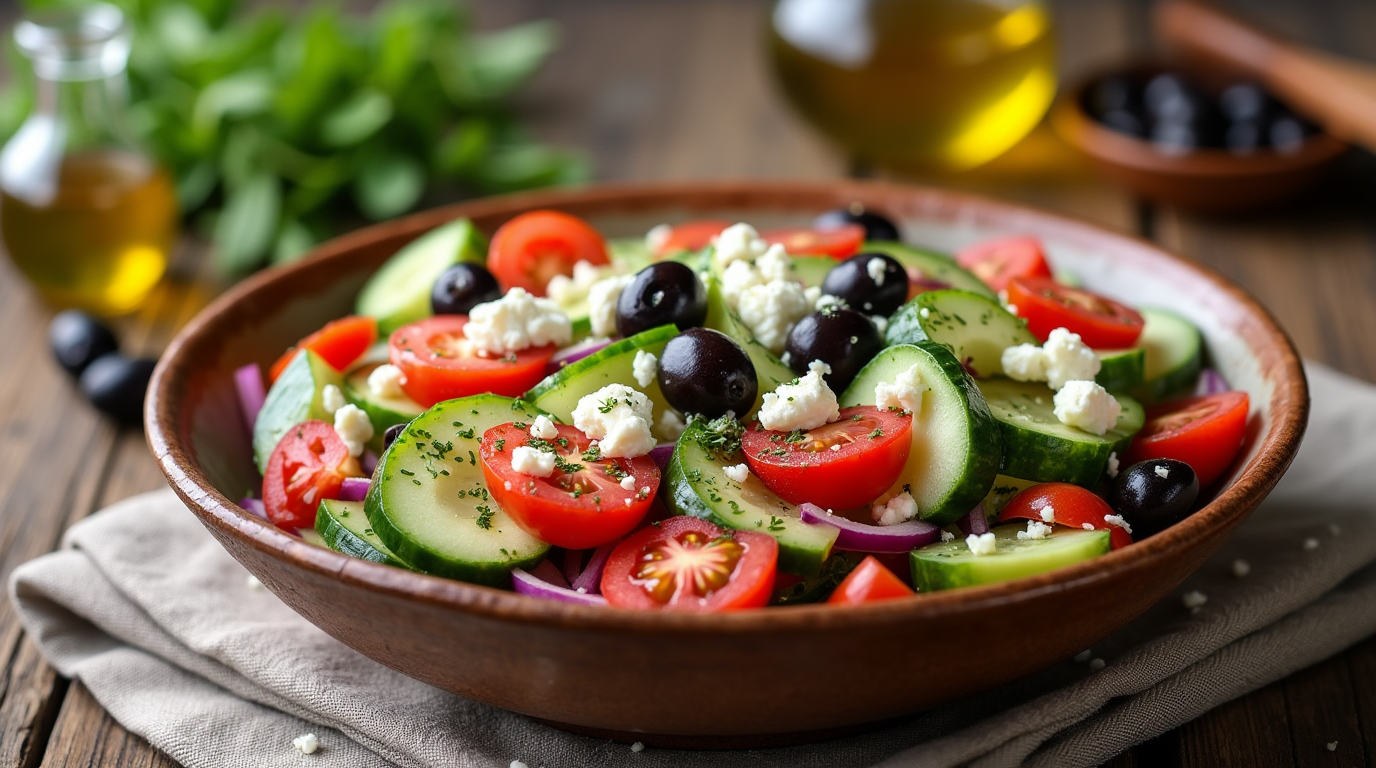Greek Salad: A Delicious Way to Eat More Veggies
Imagine this: you’re sitting outside on a warm afternoon, the sun gently kissing your skin, and in front of you is a vibrant bowl of Rustic Greek Salad with Feta & Olives. With every bite, you’re tasting the fresh, wholesome goodness of summer. This isn’t just any salad—it’s a vibrant, Mediterranean-inspired dish that transports you to the sun-soaked shores of Greece with each crisp, tangy bite.
A classic Greek salad combines the simplest of ingredients to create a dish bursting with flavor. It’s more than just a salad; it’s a celebration of fresh vegetables, rich feta cheese, and briny olives. Whether you’re looking for a refreshing side dish or a light, healthy meal, this Rustic Greek Salad is perfect for any occasion. Let’s dive into this delightful recipe that will soon become a staple in your kitchen.
What is a Greek Salad?
A Greek Salad, also known as Horiatiki, is a traditional dish that embodies everything Mediterranean—simple, healthy, and full of flavor. It’s a cornerstone of Greek cuisine, often served as an appetizer or a side dish. Typically made with tomatoes, cucumbers, red onions, olives, and feta cheese, Greek Salad is dressed with olive oil, dried oregano, and sometimes a splash of red wine vinegar or lemon juice.
The key to this salad’s incredible flavor is the freshness and quality of its ingredients. Greek cuisine is all about relying on the natural flavors of the ingredients, allowing them to shine in their simplicity. With Rustic Greek Salad with Feta & Olives, you’ll not only taste the vibrancy of the Mediterranean but also feel a sense of connection to generations of Greek cooks who have passed down this timeless recipe.
Key Ingredients for a Rustic Greek Salad
To make the perfect Rustic Greek Salad, you’ll need the best ingredients that the Mediterranean has to offer. Here’s what you need:
- Fresh Vegetables: These are the backbone of the salad.
- Tomatoes: For a juicy, sweet flavor, use heirloom or Roma tomatoes. Their vibrant color and natural sweetness elevate the dish.
- Cucumbers: Sliced thick for a crunchy texture that balances the softness of the feta and olives.
- Red Onion: Thinly sliced for just the right amount of bite and sharpness.
- Olives & Feta: These ingredients add saltiness and creaminess that are quintessential to a Greek Salad.
- Kalamata Olives: Their rich, tangy flavor is the perfect match for the fresh vegetables. Make sure they’re pitted and halved for ease of eating.
- Feta Cheese: Traditional Greek feta made from sheep’s milk (or a blend of sheep and goat’s milk) has a creamy, crumbly texture and a sharp, tangy flavor that is non-negotiable in a Greek salad.
- Herbs and Dressing: These elevate the salad, adding a Mediterranean flair.
- Olive Oil: The heart of the dressing, extra virgin olive oil is essential for its rich, full flavor.
- Oregano: Dried oregano brings that classic Mediterranean aroma, a must for any Greek Salad.
- Red Wine Vinegar or Lemon Juice: For a slight tang that enhances the other flavors. You can adjust to taste.
Table: Ingredients for Rustic Greek Salad
| Ingredient | Quantity | Notes |
|---|---|---|
| Tomatoes | 2-3 medium | Cut into chunks |
| Cucumbers | 1 large | Sliced thickly |
| Red Onion | 1 small | Thinly sliced |
| Kalamata Olives | 1/2 cup | Pitted and halved |
| Feta Cheese | 1 cup | Crumbled or in large blocks |
| Olive Oil | 3 tbsp | Extra virgin |
| Dried Oregano | 1 tsp | |
| Red Wine Vinegar | 1 tbsp | Optional |
Step-by-Step Guide to Making Rustic Greek Salad

Making Rustic Greek Salad with Feta & Olives is as easy as it gets. Here’s your step-by-step guide:
Preparing the Ingredients
- Start by washing your vegetables thoroughly.
- Slice the cucumbers into thick rounds or half-moons for added crunch.
- Cut the tomatoes into hearty chunks. You want them to retain their juiciness, so don’t slice them too thin.
- Slice the red onion thinly. If you find the onion too sharp, rinse the slices under cold water to mellow them out a bit.
Assembling the Salad
- In a large salad bowl, combine the tomatoes, cucumbers, red onion, and olives. Toss them gently to mix.
- Add the feta cheese on top or mix it gently into the vegetables, depending on your preference.
Dressing the Salad
- Drizzle the olive oil generously over the salad. You can add more or less depending on how dressed you like your salads.
- Sprinkle the dried oregano evenly over the top. The aroma will transport you straight to Greece.
- Optionally, splash in the red wine vinegar or lemon juice to brighten up the salad and add a touch of acidity.
- Season with salt and pepper to taste.
Let the salad sit for a few minutes to allow the flavors to meld together, then serve and enjoy!
Health Benefits of Rustic Greek Salad
Not only is Rustic Greek Salad with Feta & Olives incredibly delicious, but it’s also packed with health benefits. Here’s why this Mediterranean salad is a smart choice:
- Rich in Nutrients: The fresh vegetables in Greek Salad—like tomatoes, cucumbers, and red onions—are full of vitamins and antioxidants. Tomatoes, for example, are a great source of vitamin C and lycopene, a powerful antioxidant that supports heart health.
- Heart-Healthy Ingredients: Olive oil is packed with monounsaturated fats, which are known to promote heart health by lowering bad cholesterol levels. Kalamata olives are also rich in antioxidants, which help reduce inflammation and support overall well-being.
- Low-Carb and Refreshing: This salad is naturally low in carbs and gluten-free, making it perfect for anyone following a keto or gluten-free diet. It’s also light yet satisfying, keeping you full without feeling sluggish.
Variations on the Classic Greek Salad
If you want to get creative with your Rustic Greek Salad, there are plenty of ways to make it your own:
- Add Proteins: Grilled chicken, lamb, or shrimp are great additions to turn the salad into a heartier meal. For a vegetarian option, try adding chickpeas or grilled tofu.
- Other Toppings: You can also mix in roasted peppers, capers, or even a sprinkle of crushed nuts like almonds or walnuts for added crunch.
- Incorporating Grains: Want to make it even more filling? Add quinoa or couscous to your Greek Salad to turn it into a complete, satisfying meal.
How to Serve and Pair Rustic Greek Salad
As a Side Dish
This salad is the perfect accompaniment to grilled meats like chicken, lamb, or beef. It also works wonderfully as a side dish for Mediterranean dishes like moussaka or souvlaki.
As a Main Course
When you add protein or grains, this Rustic Greek Salad can stand alone as a light lunch or dinner. Its balance of fresh vegetables, tangy feta, and olives makes it a complete and satisfying meal.
Wine Pairing
To complement the fresh flavors of the salad, pair it with a crisp white wine, such as Sauvignon Blanc, or a light, chilled rosé. These wines enhance the salad without overpowering its delicate flavors.
Common Questions About Greek Salad
What is the Best Feta Cheese for Greek Salad?
For an authentic Greek Salad, always choose Greek-style feta cheese, made from sheep’s milk or a blend of sheep and goat’s milk. This type of feta has a creamy, slightly crumbly texture and a tangy flavor that’s essential for the salad’s taste.
Can I Make Greek Salad in Advance?
Greek Salad is best served fresh, but you can prepare the vegetables and store them separately from the dressing. When you’re ready to serve, simply toss everything together with the dressing. This ensures the salad stays crisp and fresh.
Is Greek Salad Good for Weight Loss?
Yes! This salad is low in calories but high in fiber and healthy fats. The fresh vegetables and olive oil provide nutrients that help you feel full without consuming excess calories, making it a great option for weight management.
Conclusion
There’s something incredibly satisfying about a Rustic Greek Salad with Feta & Olives. It’s simple, refreshing, and packed with vibrant Mediterranean flavors. With its combination of fresh vegetables, tangy feta, briny olives, and rich olive oil, this salad is a celebration of everything that makes Greek cuisine so beloved around the world.
Whether you’re serving it as a side dish or enjoying it as a light main course, Greek Salad is a versatile, healthy option that’s perfect for any occasion. So, gather your ingredients, prepare your Greek Salad, and enjoy the fresh, wholesome flavors that will transport you straight to Greece.
FAQ
What is the traditional dressing for Greek Salad?
The traditional dressing for Greek Salad is a simple mixture of extra virgin olive oil, dried oregano, and sometimes red wine vinegar or lemon juice. It enhances the fresh flavors of the vegetables and cheese without overwhelming them.
Can I Substitute Olives in Greek Salad?
Kalamata olives are traditional in Greek Salad, but you can swap them for green olives or other types of olives, though the flavor will change slightly. Kalamata olives provide the most authentic taste.
Can Greek Salad be Made Vegan?
Yes! To make Rustic Greek Salad with Feta & Olives vegan, simply omit the feta cheese or use a plant-based feta alternative. The rest of the salad is naturally vegan and just as delicious!

